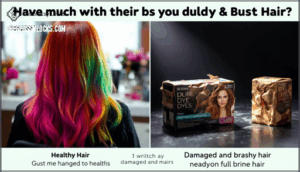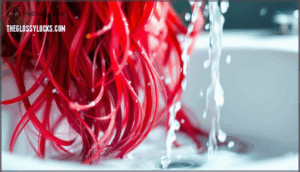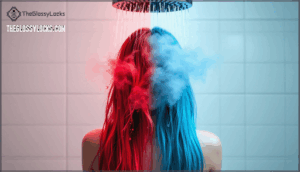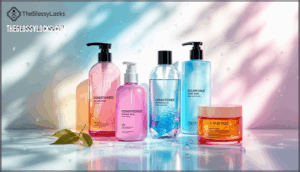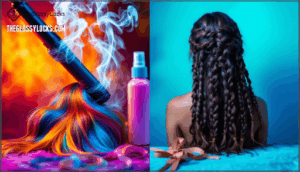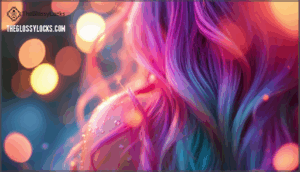This site is supported by our readers. We may earn a commission, at no cost to you, if you purchase through links.

The 48 to 72-hour waiting period isn’t beauty industry folklore—it’s the time your hair’s cuticle needs to seal shut and lock in those color molecules you just paid for. Studies show that hair washed according to this timeline retains 22% more color after a month compared to hair washed immediately.
Understanding how long to wait to wash hair after dyeing protects your color from premature fading and keeps that salon-fresh shade looking sharp for weeks longer.
Table Of Contents
- Key Takeaways
- How Long to Wait to Wash Hair After Dyeing
- Shampooing The Day After Coloring
- Throwing Box Dye Over Fresh Salon-colored Hair
- Washing Hair Too Often
- Rinsing With Hot Water
- Using The Right Conditioner for Color-treated Hair
- Drying Hair Gently With a Towel
- Limiting Heat Styling Tools
- Protecting and Hydrating Dyed Hair
- Avoiding Overexposure to The Sun
- Frequently Asked Questions (FAQs)
- How long should I wait to wash my hair after color?
- How long after dyed hair should you wash your hair?
- Should you wash your hair before coloring?
- How often should you wash your hair before coloring?
- Should you wash your hair after a color service?
- Does hair color fade if you wash it before washing?
- How can I protect my colored hair from the sun?
- What is the best way to rinse out hair dye?
- Can I swim after dyeing my hair?
- Does hair dye damage natural hair oils?
- Conclusion
Key Takeaways
- Waiting 48 to 72 hours before your first wash after dyeing allows the cuticle to fully close and seal in color molecules, preventing up to 22% more color loss over 30 days compared to immediate washing.
- Hot water forces cuticles open and accelerates color bleeding, so switching to lukewarm or cool rinses significantly extends vibrancy and protects your investment.
- Limiting washes to two or three times weekly with sulfate-free, color-safe products prevents stripping dye molecules and reduces the need for touch-ups by 15% over six months.
- Heat styling tools above 300°F, UV exposure, and rough towel-drying all compromise the cuticle structure where color lives, making protective products, gentle handling, and heatless styles essential for long-lasting results.
How Long to Wait to Wash Hair After Dyeing
After that color appointment, the real care begins—but it doesn’t require waiting weeks. The magic window? Forty-eight to seventy-two hours before your first wash. This recommended waiting period isn’t folklore; it allows the cuticle closure timing to complete and color molecules to finish settling deep inside each strand.
Premature washing effects include faster hair color fading because you’ve disrupted pigment settling before the hair dye locks in. As a matter of fact, washing colored hair too frequently can cause color loss.
Studies show that hair washed according to these timelines retained twenty-two percent more color after thirty days compared to early shampooing. Skip that immediate wash, and you’re buying yourself weeks of vibrancy.
Wait the full 48-72 hours after dyeing—hair retains 22% more color after thirty days compared to washing early
Shampooing The Day After Coloring
If you’re tempted to lather up twenty-four hours after leaving the salon, you’re not alone—but you’re risking a costly mistake. Premature washing opens the door to three immediate problems:
- Color fading accelerates as unsettled pigments wash down the drain before bonding completely
- Cuticle damage worsens when the outer layer hasn’t fully sealed, leaving strands vulnerable
- Product buildup from the dye process needs time to stabilize, not immediate disruption
Shampooing this early strips away your investment. The cuticle remains partially open during those first twenty-four hours, meaning hair color fading happens faster than it should. Some clients report scalp irritation from rushing the process too.
Washing hair after dyeing demands patience—your color’s longevity depends on it. Follow proper hair care tips and wait the full forty-eight to seventy-two hours. That discipline prevents hair damage and keeps your shade vibrant weeks longer.
Throwing Box Dye Over Fresh Salon-colored Hair
You’ve waited patiently after your salon visit, but now you’re eyeing that box dye at the drugstore—stop right there. Applying box dyes over fresh salon color can strip the carefully deposited pigment and cause severe hair damage.
These one-size-fits-all formulas contain harsh chemicals that don’t account for your stylist’s custom work, leading to brassy tones, uneven fading, or DIY color gone wrong. The result? Professional intervention needed and a color correction cost that’ll run you triple what you paid initially.
Always consult your colorist before making changes—they’ll recommend safe alternatives that protect your investment.
Washing Hair Too Often
Overwashing creates a fast track to dull, faded color—think of it like scrubbing a painting until the pigments wash away. Every shampoo session strips some dye molecules from your hair shaft, especially when dealing with porous cuticles from bleaching. Research shows hair washed prematurely after coloring loses up to 22% more pigment over 30 days compared to properly maintained color.
Limit washing to two or three times weekly. Between washes, dry shampoo becomes your best friend for absorbing oil without triggering color fade. Shampoo ingredients matter tremendously—sulfates and clarifying formulas accelerate fading by opening the cuticle and releasing color molecules. As a result, it’s important that sulfates strip hair due to their harsh cleansing properties. Water temperature effects are significant too; hot water forces cuticles open, allowing color to bleed out faster than you’d expect.
Color-safe products paired with cooler water temperatures protect your investment. Stretching your wash cycle reduces touch-up appointments by 15% over six months, keeping both your hair and wallet healthier.
Rinsing With Hot Water
Hot water acts like a fast-forward button on color fade—each steamy rinse forces your hair cuticles wide open, letting those freshly deposited dye molecules wash straight down the drain. Think of your cuticle as a protective barrier that reacts to water temperature like a thermostat—hot showers trigger it to lift, creating gaps where color bleeds out rapidly. This is especially problematic within the first 72 hours after hair dyeing when pigments haven’t fully settled.
Switch to lukewarm or cool water for washing hair to seal those cuticles shut and trap color inside. The difference is measurable: cooler temperatures slow color bleeding considerably, extending vibrancy between salon visits. Even if you’re using color-safe products, hot water undermines your fading prevention efforts entirely.
Your hair color investment deserves this simple adjustment. Cool rinses might feel less relaxing initially, but they’re non-negotiable for maintaining that fresh-from-the-salon look weeks longer.
Using The Right Conditioner for Color-treated Hair
Beyond shampooing, conditioner choice determines whether your color lasts or fades fast. Generic conditioners can’t shield color-treated hair from protein loss—studies show properly formulated products reduce breakage by up to 28% while extending vibrancy for four weeks post-coloring. Look for protein conditioners containing hydrolyzed keratin or panthenol, which reinforce damaged cuticles and boost moisture retention by 18%.
Color-depositing conditioners work double duty, revitalizing pigment with each wash while maintaining hydration balance. Use them weekly to prevent uneven tones. Color-safe products should include argan oil for 21% improved smoothness and shea butter for heat protection. Ingredients like polyquaternium-10 cut detangling time by 37%, preventing mechanical damage during styling.
UV protection matters too—specialized hair care products shield against environmental fade. The market’s flooded with options, but formulas with silanetriol and dimethicone deliver measurable results for color-treated hair longevity.
Drying Hair Gently With a Towel
After all the work you put into achieving your perfect shade, the way you towel-dry can make or break your color’s staying power. Rough rubbing with a standard cotton towel creates friction that lifts the hair cuticle—exactly what causes dyed hair to fade faster. Instead, use microfiber towels for drying hair. Their ultra-fine fibers absorb water 50% more efficiently than cotton while reducing frizz by up to 40%.
Blotting vs. rubbing makes all the difference in hair care. Gently press sections of your hair between the towel rather than scrubbing back and forth. This protects the cuticle structure where your color molecules live. For maximum color retention, let hair air dry partway before using heat tools. Air drying benefits include less mechanical damage and better moisture balance.
Your hair washing routine matters, but how you treat wet, freshly dyed hair afterward determines whether that salon investment lasts six weeks or six days.
Limiting Heat Styling Tools
Every time you reach for that flat iron or curling wand, you’re literally evaporating your color investment at temperatures that can exceed 400°F. Heat styling products strip moisture and open the cuticle—that’s the gateway to hair damage from dyeing and rapid color fade.
Temperature control is your first defense. Keep tools below 300°F for color-treated hair, and never skip heat protectants. These spray-on barriers create a thermal shield between your tool and your hair color. For best results, apply to damp hair before blow-drying or on dry sections before hot styling.
Better yet, embrace heatless styles whenever possible. Braids, twists, and foam rollers deliver texture without compromising hair health after dyeing. Air drying retains up to 30% more color vibrancy over time compared to daily heat exposure.
Tool quality matters, too. Ceramic or titanium plates distribute heat evenly, preventing hot spots that cause uneven hair damage from dyeing. Your color longevity depends on these daily decisions.
Protecting and Hydrating Dyed Hair
Your color-treated hair needs the same care as a prized silk scarf—delicate treatment and regular hydration. Deep conditioning treatments restore moisture lost during the coloring process, while sulfate-free products prevent the harsh stripping that accelerates fade. A color-safe routine isn’t optional; it’s how you protect your investment from daily wear.
Caring for dyed hair means treating it like the delicate, porous structure it’s become. Post-dye hair care centers on replenishing what coloring removes—natural oils, protein, and sealed cuticles. Hair hydration isn’t just about feeling soft; it’s about trapping color molecules inside where they belong.
Think of hydration methods as your hair’s defense system:
- Weekly moisture-rich shampoo and conditioner lock in pigment while nourishing stressed strands
- UV protection sprays or leave-ins shield against sun damage that dulls color intensity
- Overnight repair masks work while you sleep, rebuilding bonds weakened during processing
Avoiding Overexposure to The Sun
The sun might feel great on your skin, but it’s one of the fastest ways to bleach your freshly dyed hair back to dullness. UV hair damage works like a slow chemical strip, breaking down color molecules you just sealed in. Think of sun exposure as your color’s worst enemy—prolonged rays oxidize pigment and dry out strands, making protecting color-treated hair non-negotiable.
Preventing hair color fade from sun damage requires layered defense:
| Protection Method | How It Works |
|---|---|
| UV protection sprays | Create a barrier against rays that cause color fading prevention |
| Hats or scarves | Physical shields limit direct sun exposure on vulnerable strands |
| Color-safe products with SPF | Sunscreen for hair locks in pigment while blocking damage |
Protective hairstyles like braids minimize surface area exposed to harmful rays. When you’re outside for extended periods, reapply UV sprays just like you’d facial sunscreen. Hat hair care means choosing breathable fabrics that won’t trap moisture while still shielding your investment from fading.
Frequently Asked Questions (FAQs)
How long should I wait to wash my hair after color?
You’ll want to give your color a proper chance to lock in before hitting the shower. Wait at least 48 to 72 hours—3 full days—after dyeing to let the cuticle closure complete and allow pigment settling, which prevents premature washing from undermining your hair color retention.
How long after dyed hair should you wash your hair?
After dyeing, wait 48 to 72 hours before shampooing. This cuticle closure timing allows pigment settling, preventing premature color fade.
Washing hair after dyeing too soon can compromise your postdye hair care efforts and reduce vibrancy.
Should you wash your hair before coloring?
You don’t need to shampoo before dyeing hair—colorists usually take care of a pre-dye cleanse at the salon.
However, arrive with relatively clean hair, free of heavy product residue and scalp buildup, which can interfere with color absorption and affect hair porosity during the dye application process.
How often should you wash your hair before coloring?
Your hair wash frequency before dyeing hair should mirror your usual routine—no special prep needed. Colorists take care of pre-dye cleansing to control scalp oil levels and product buildup.
Skip harsh sulfates that might affect hair porosity, which influences how color absorbs. Your hair health matters more than timing.
Should you wash your hair after a color service?
Yes, salons wash your hair immediately after a color service to remove excess dye. Immediate shampooing at the salon is fine, but give your color a post-dye breather at home—waiting 72 hours before your next wash maximizes color longevity.
Does hair color fade if you wash it before washing?
Absolutely. Immediate shampoo effects matter—early washing risks color molecule settling and disrupts cuticle closure time, accelerating pigment wash-out.
Waiting 72 hours (3 days) is essential for color retention after dyeing and hair color fading prevention.
How can I protect my colored hair from the sun?
Think of sun exposure like bleach on fabric—it strips color-treated hair fast. Wear hats with UV protection, apply hair products containing UV blockers, and use scalp sunscreen on your part. Protective hairstyles like braids minimize damage.
Color-safe products with hydration importance help maintain vibrancy while protecting color-treated hair from UV hair damage and supporting hair color fading prevention through consistent color protection.
What is the best way to rinse out hair dye?
Start by using cold water—it’s your first line of defense against color bleeding and fading. Rinse thoroughly until the water runs completely clear, protecting your fresh hair coloring investment.
Follow with a color-safe conditioner to seal the cuticle and lock in vibrancy.
Can I swim after dyeing my hair?
Wait at least 72 hours before swimming. Chlorine and saltwater strip fresh color quickly, causing color bleeding and fading.
Pool chemicals damage color-treated hair. If you must swim, wear a swim cap and rinse immediately with cool water for color protection and retention after dyeing.
Does hair dye damage natural hair oils?
Chemical processing alters scalp health and hair porosity, stripping natural oils temporarily. Most hair dye ingredients cause some oil depletion.
Your scalp compensates by ramping up oil production within days, though damaged hair may need extra conditioning for oil replacement.
Conclusion
Color care isn’t rocket science—it’s more like dye-namics. The 48 to 72-hour rule for how long to wait to wash hair after dyeing gives your cuticle time to close and lock in pigment molecules.
Follow it, skip the hot water, use sulfate-free products, and limit heat styling. Your hair color won’t maintain itself, but these habits guarantee you’re not washing away weeks of vibrancy with one rushed shampoo.
Protect your investment, and your color will return the favor.
- https://www.wella.com/professional/en-US/blog/hair-care/can-you-wash-hair-24-hours-after-coloring
- https://salonmignyon.com/how-soon-can-you-wash-hair-after-highlights/
- https://pubs.acs.org/doi/10.1021/acs.chemrestox.1c00427
- https://www.newbeauty.com/things-you-shouldnt-do-after-coloring-your-hair/
- https://www.lorealparisusa.com/beauty-magazine/hair-color/hair-color-application/should-you-wash-hair-before-coloring


